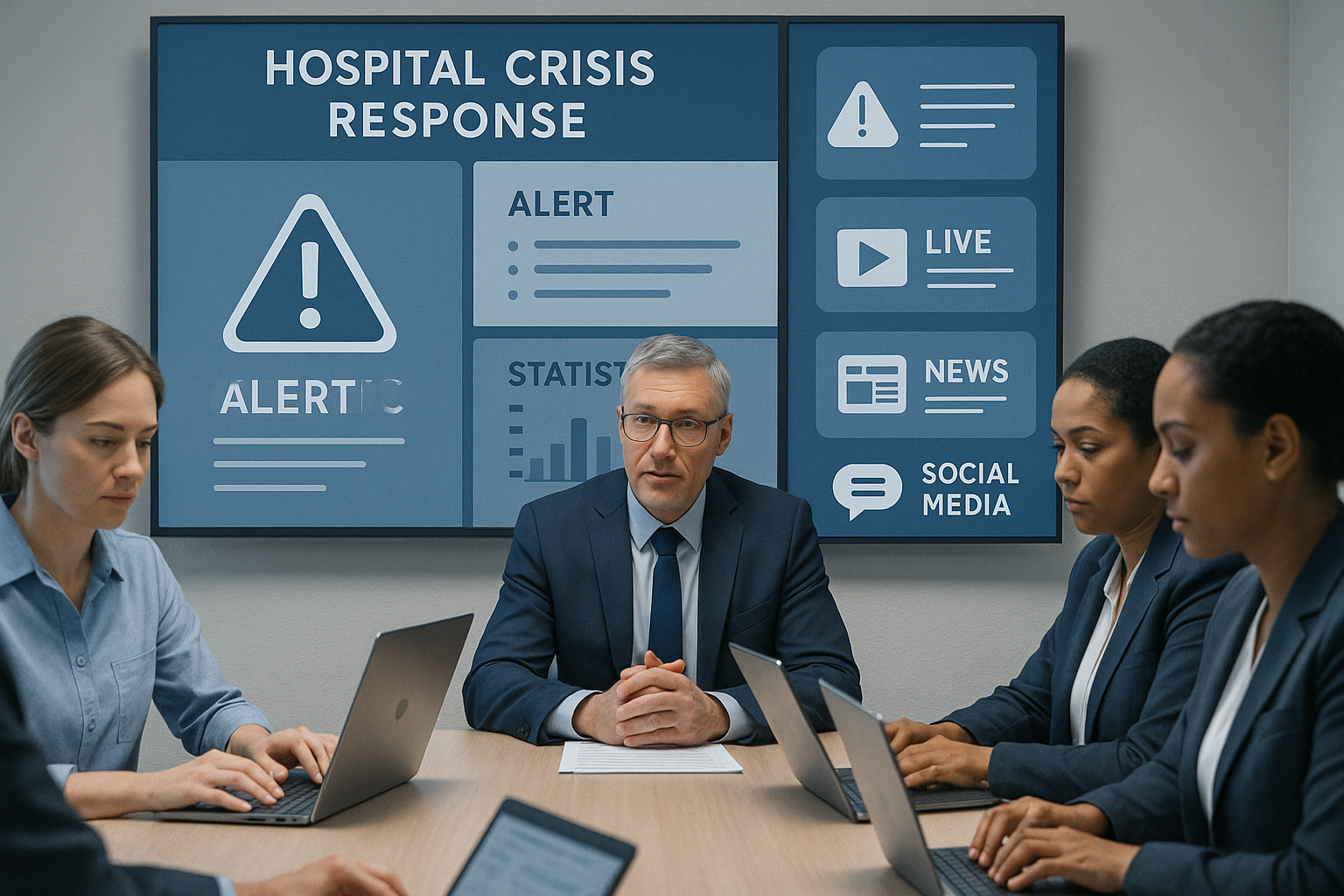It’s 6:47 AM on a Tuesday when the CMO’s phone rings. A patient died overnight following a surgical complication. By 7:15 AM, the patient’s daughter has posted an emotional, detailed account on Facebook. By 8:00 AM, local media outlets are calling. By 9:00 AM, the post has 2,000 shares, #JusticeFor[PatientName] is trending locally, and a television crew is setting up in the hospital parking lot.
The CEO calls an emergency meeting. All eyes turn to the marketing leader: “What do we say? When? Who says it? How do we stop this from destroying our reputation?”
This scenario—or variations of it—plays out at healthcare organizations regularly. A medical error. A data breach. A physician misconduct allegation. A pandemic outbreak. A disgruntled employee’s viral video. An environmental contamination. A workplace violence incident. The triggers vary, but the stakes are always high: patient trust, community reputation, staff morale, financial stability, and in some cases, organizational survival.
Crisis communication in healthcare is uniquely challenging. Unlike other industries, healthcare crises often involve:
Life-and-death consequences: Real harm to real people, not just financial or reputational damage
Intense emotions: Fear, grief, anger from patients and families
Regulatory scrutiny: HIPAA, state health departments, CMS, law enforcement
Media amplification: Healthcare crises attract intense media attention
Social media velocity: Information (and misinformation) spreads instantly
Community impact: Hospitals are community institutions; crises affect everyone
Complex stakeholders: Patients, families, staff, physicians, board, community, regulators, media
According to Institute for Healthcare Improvement research, 70% of healthcare organizations experience a significant crisis every 3-5 years, yet only 40% have comprehensive crisis communication plans in place.
This comprehensive guide provides hospital marketing leaders with frameworks, strategies, and lessons learned from real healthcare crises—enabling you to prepare for, navigate through, and recover from the communication challenges that inevitably arise.
Understanding Healthcare Crisis Types
Different crises require different communication approaches.
Clinical Quality and Patient Safety Crises
Examples:
Surgical errors or complications
Medication errors
Hospital-acquired infections
Wrong-site surgeries
Patient injuries or deaths from preventable causes
Communication challenges:
HIPAA restrictions on discussing patient information
Balance between transparency and liability concerns
Need to maintain patient/family trust while investigating
Staff morale and fear
Regulatory reporting requirements
Stakeholders: Affected patients/families, other patients, staff, physicians, board, regulators, media, community
Data and Privacy Breaches
Examples:
Ransomware attacks
Hacking and data theft
Unauthorized access to records
Lost or stolen devices
Vendor breaches
Communication challenges:
Legal requirements for breach notification
Technical complexity difficult to explain
Ongoing investigation limits what can be shared
Patient fear and anger about privacy violation
Coordination with law enforcement and regulators
Stakeholders: Affected patients, all patients, staff whose data may be compromised, regulators (OCR, state attorneys general), media, cybersecurity community
Workplace Violence and Safety Incidents
Examples:
Active shooter situations
Staff assaults
Patient or visitor violence
Workplace harassment allegations
Safety protocol failures
Communication challenges:
Real-time crisis communication during ongoing threat
Staff safety and trauma
HIPAA considerations if patients involved
Law enforcement information coordination
Balancing transparency with ongoing investigation
Stakeholders: Staff, patients on-site, families, law enforcement, media, community, potential patients concerned about safety
Leadership and Governance Crises
Examples:
Executive misconduct
Financial fraud or mismanagement
Board conflicts
Physician credentialing issues
Sexual harassment allegations
Communication challenges:
Legal constraints on what can be shared
Board and leadership alignment on messaging
Staff morale and trust
Competitor exploitation of situation
Potential for ongoing investigations
Stakeholders: Staff, physicians, board, patients, community, donors, business partners, media
Public Health Emergencies
Examples:
Disease outbreaks (COVID-19, measles, etc.)
Environmental contamination
Mass casualty events
Natural disasters
Terrorism
Communication challenges:
Rapidly evolving situation and information
High volume of inquiries
Need to coordinate with public health authorities
Public fear and misinformation
Operational disruptions affecting communication channels
Stakeholders: Entire community, staff, patients, public health agencies, government officials, media, other healthcare providers
Social Media and Reputation Crises
Examples:
Viral negative patient reviews or complaints
Staff social media misconduct
Controversial physician statements
Perceived discrimination or bias
Tone-deaf marketing campaigns
Communication challenges:
Speed of social media spread
Emotional and often inaccurate narratives
Multiple platforms requiring monitoring
Balance between responding and amplifying
Distinguishing legitimate concerns from trolling
Stakeholders: Social media community, patients (current and prospective), staff, media monitoring social channels, online influencers
The Crisis Communication Framework
Effective crisis response follows a structured approach.
Phase 1: Preparation (Before Crisis)
Crisis communication team:
Leader: CMO or communications director
Core team: Marketing/communications, legal, clinical leadership, operations, HR, IT (for tech crises)
Advisors: CEO, medical staff leadership, public relations agency
Clear roles: Who does what, decision-making authority, escalation paths
Crisis communication plan:
Crisis definitions and classification (severity levels)
Activation protocols (who calls crisis, how team assembles)
Communication workflows and approval processes
Stakeholder contact lists (updated quarterly)
Message templates for common scenarios
Media protocols and spokesperson training
Social media monitoring and response protocols
Employee communication channels
Command center setup instructions
Message development:
Pre-drafted holding statements for various crisis types
Core values and commitments to reference
Key stakeholder messages
Q&A documents for likely scenarios
Training and drills:
Annual crisis communication simulation exercises
Media training for spokespersons
Social media team training
Staff education on crisis protocols
Table-top exercises testing plans
Monitoring systems:
Social media monitoring tools
Google Alerts for organization mentions
Media monitoring services
Internal reporting mechanisms for early issue identification
According to CDC emergency communication guidelines, organizations with comprehensive preparedness plans and trained teams resolve crises 50% faster with 60% less reputational damage.
Phase 2: Response (During Crisis)
First 1-3 hours (Golden Hour):
Activate crisis team:
Assemble core team immediately
Assess situation and gather facts
Classify crisis severity
Activate communication protocols
Establish command structure:
Clear decision-maker identified
Information flow established
Legal review process defined
Approval hierarchy clarified
Initial internal communication:
Notify staff immediately (before they hear externally)
Brief talking points for staff
Instructions on directing inquiries
Reassurance and support
Holding statement prepared:
Acknowledge situation
Express concern/compassion
Commit to investigation/transparency
Provide timeline for updates
Note: May not be released publicly immediately, but ready when needed
Example holding statement:
“We are aware of [situation]. The safety and wellbeing of our patients and staff are our highest priorities. We are investigating thoroughly and will provide updates as we have confirmed information. Our thoughts are with [affected parties].”
First 24 hours:
Gather and verify information:
What happened? When? Where? Who was affected?
What is confirmed vs. unconfirmed?
What are immediate next steps?
What are implications for patients, staff, operations?
Stakeholder communication:
Affected patients/families (personal outreach)
Staff (frequent updates via email, intranet, meetings)
Board and leadership (formal briefing)
Physicians (medical staff communication)
Regulators (required notifications)
Media (initial statement if public)
Media management:
Designate single spokesperson
Prepared statements released
Media inquiries logged and responded to
Press conference scheduled if warranted
Social media responses coordinated
Social media monitoring:
Track mentions and sentiment
Identify misinformation to correct
Respond to direct questions
Provide factual updates
Days 2-7 (Active Crisis):
Regular updates:
Scheduled update intervals (daily or more frequent)
Consistency across all channels
Progressive information disclosure
Transparency about investigation progress
Stakeholder engagement:
Personal outreach to most affected
Town halls or forums for staff
Community forums if appropriate
One-on-one meetings with key stakeholders
Message refinement:
Adjust based on feedback and questions
Address emerging concerns
Correct misinformation
Show progress and action
Documentation:
Timeline of events
Decisions made and rationale
All communications issued
Media coverage tracking
Social media sentiment analysis
Phase 3: Recovery (After Acute Crisis)
Ongoing communication (Weeks to Months):
Transparency about findings:
Share investigation results appropriately
Acknowledge failures honestly
Explain root causes identified
Present corrective actions clearly
Action and improvement:
Detailed improvement plans
Timeline for implementation
Progress updates regularly
Third-party validation if appropriate
Rebuild trust:
Consistent follow-through on commitments
Visible leadership engagement
Patient and staff feedback mechanisms
Community engagement and listening
Staff support and recovery:
Address staff trauma and stress
Recognize staff efforts during crisis
Provide counseling resources
Rebuild morale and confidence
Return to normal:
Gradual shift from crisis communication mode
Positive stories and regular messaging resume
Continue monitoring for lingering concerns
Prepare for anniversary reactions
Phase 4: Learning and Improvement:
After-action review:
What happened and why?
What went well in our response?
What could have been better?
What should we change?
Plan updates:
Revise crisis communication plan
Update message templates
Improve monitoring systems
Enhance training
Knowledge sharing:
Document lessons learned
Share insights across organization
Train new team members
Update board and leadership
The Ten Commandments of Healthcare Crisis Communication
Essential principles for effective response.
1. Speed Matters—Be First, Be Right, Be Credible
Why: In information vacuums, speculation and misinformation thrive. If you don’t tell your story, others will tell it for you—often inaccurately.
How:
Respond within first hour if possible
Initial response can be brief acknowledgment
“We’re investigating and will provide updates” is valid
Don’t wait for perfect information
Balance speed with accuracy
Example: Hospital becomes aware of data breach at 7 AM. By 9 AM, issues statement acknowledging incident, describing immediate response, and committing to updates. This establishes them as primary information source before media speculation begins.
2. Tell the Truth—Always, Completely, Quickly
Why: Lies or half-truths are always discovered. Cover-ups destroy credibility permanently. Transparency builds trust even during crises.
How:
Share what you know and admit what you don’t
Correct errors immediately
Disclose bad news proactively
Avoid legalistic evasions
If you can’t discuss something (legal/HIPAA reasons), explain why
What to avoid:
“No comment”
Minimizing or downplaying
Blaming others
Technical jargon to obscure truth
What to say:
“Here’s what we know…”
“We’re still investigating…”
“We take full responsibility…”
“Here’s what we’re doing to fix this…”
3. Show Genuine Empathy and Compassion
Why: Healthcare crises involve human suffering. Tone-deaf, corporate responses inflame situations. Authentic compassion resonates.
How:
Lead with empathy
Acknowledge pain and fear
Use human language, not corporate speak
Visible leadership presence
Personal outreach to most affected
Example: Instead of “The organization regrets the incident,” say “Our hearts go out to the [Patient] family. No family should experience this pain. We are deeply sorry.”
4. Take Responsibility—Own It
Why: Deflecting blame or making excuses destroys credibility. Taking ownership—even when difficult—builds respect and trust.
How:
Use “we” not “they” or “it”
Avoid passive voice that obscures responsibility
Don’t blame individuals, systems, or circumstances
Acknowledge what you should have done differently
Commit to doing better
Example: “We should have identified this risk earlier. We didn’t. That’s on us, and we’re implementing changes to ensure it doesn’t happen again.”
5. Explain Action—What You’re Doing to Fix It
Why: People want to know you’re not just apologizing but actively addressing the problem. Action restores confidence.
How:
Immediate actions taken
Short-term corrective measures
Long-term systemic improvements
Timeline for implementation
How you’ll measure success
Third-party oversight if appropriate
Example: “We’ve immediately: [immediate steps]. Within 30 days we will: [short-term fixes]. Over the next six months: [systemic improvements]. We’ll report progress monthly.”
6. Communicate Through Multiple Channels
Why: Different stakeholders consume information through different channels. Multi-channel approach ensures message reaches everyone.
Channels:
Press release and media statements
Website dedicated crisis page
Social media (Twitter, Facebook, LinkedIn)
Email to patients, staff, stakeholders
In-person briefings (staff, affected families, community)
Letters or direct mail if appropriate
Patient portal messages
Intranet for staff
7. Designate and Prepare Spokespersons
Why: Inconsistent messages from multiple voices create confusion. Trained spokespersons deliver clear, consistent messages and handle pressure.
Spokesperson selection:
CEO for most serious crises
CMO or medical leader for clinical crises
CISO for cybersecurity incidents
Legal counsel rarely (typically too defensive/technical)
Spokesperson preparation:
Media training before crisis occurs
Message internalization
Difficult question preparation
On-camera presence training
Stress management techniques
What spokespersons should do:
Stay on message
Bridge back to key points
Acknowledge emotions in questions
Speak in plain language
Show composure and confidence
Express appropriate empathy
What to avoid:
“No comment”
Speculation
Hypotheticals
Answering questions they don’t know answers to
Defensive body language
Jargon or technical language
8. Monitor, Listen, and Adjust
Why: Crises evolve rapidly. What worked hour one may not work hour twelve. Continuous monitoring enables real-time adjustments.
What to monitor:
Media coverage and framing
Social media mentions and sentiment
Stakeholder feedback and concerns
Employee questions and morale
Community reactions
Regulatory responses
How to adjust:
Identify emerging concerns and address proactively
Correct misinformation promptly
Refine messages based on what’s working
Address unintended message interpretations
Scale up or down communication based on need
9. Remember Your Employees
Why: Staff are your front-line communicators and brand ambassadors. They’re also stakeholders affected by the crisis. Supporting them is both ethical and strategic.
Employee communication priorities:
Tell staff before public/media (whenever possible)
Frequent updates (more than you think necessary)
Opportunities to ask questions and express concerns
Clear guidance on handling patient/external inquiries
Emotional support resources
Recognition of their efforts and stress
What employees need:
Facts about what happened
Context and implications
How it affects them and their work
What they should say if asked
Resources and support
Reassurance about organizational stability
10. Plan for the Long Haul
Why: Healthcare crises often have long tails. Initial crisis may resolve quickly, but recovery takes time. Sustained communication maintains trust.
Long-term communication:
Regular progress updates
Transparency about setbacks
Celebration of milestones
Ongoing stakeholder engagement
Anniversary acknowledgments
Integration of lessons into organizational culture
Case Studies: Lessons from Real Healthcare Crises
Learn from organizations that navigated crises successfully—and those that didn’t.
Case Study 1: Johns Hopkins Hospital Needle Reuse Incident (Success)
Crisis: 2008 discovery that contaminated insulin pens were shared among patients, requiring HIV and hepatitis testing for thousands.
Response:
Immediate public disclosure despite potential liability
Personal outreach to every affected patient
Free testing provided
Regular updates throughout investigation
Implementation of visible safety improvements
Third-party safety audit conducted
Ongoing transparency about changes
Results: Despite serious incident, trust recovery achieved. Media praised transparency. Patient litigation minimal compared to projections. Used as case study for effective crisis communication.
Lessons:
Rapid, transparent disclosure builds trust even in serious situations
Personal outreach to affected individuals matters immensely
Taking responsibility without qualification is powerful
Visible action and improvement demonstrate commitment
Case Study 2: Vanderbilt Medical Center Data Breach (Mixed Response)
Crisis: 2016 breach exposing 22,000 patient records through unauthorized access.
Response strengths:
Legally required notification completed
Technical explanation provided
Credit monitoring offered
Security improvements implemented
Response weaknesses:
Initial communication felt legalistic and impersonal
Limited empathy for patient anxiety
Minimal proactive updates after initial notification
Slow implementation of promised improvements
Results: Significant patient frustration and complaints. Trust recovery took years. Lawsuits filed. Used as example of technically compliant but emotionally insufficient response.
Lessons:
Legal compliance ≠ effective crisis communication
Empathy and human connection essential even in technical crises
Ongoing communication and updates maintain trust
Speed of action matters as much as promises of action
Case Study 3: Seattle Children’s Hospital Aspergillus Crisis (Failure)
Crisis: 2019 mold contamination in operating rooms linked to patient death. Hospital aware of problem for years but hadn’t fully resolved it.
Response failures:
Initial response minimized problem
Delayed disclosure of full scope
Defensive posturing
Inadequate explanation of why problem persisted
Slow action on comprehensive remediation
Results: Massive trust loss. Legislative hearings. Leadership changes. Patient exodus. Legal consequences. Reputation damage lasting years.
Lessons:
Known, unaddressed problems become catastrophic when exposed
Minimizing or defensive responses amplify damage
Delayed disclosure seen as cover-up
Inadequate action on known risks destroys credibility
Special Considerations for Social Media Crises
Social media crises require adapted strategies.
Social Media Crisis Characteristics
Speed: Exponential spread within hours
Emotion: Amplified emotional reactions
Distortion: Facts often distorted as shared
Permanence: Screenshots and archives forever
Mob dynamics: Pile-on effects and outrage culture
Social Media Response Strategy
Monitor constantly:
Real-time social listening tools
Track volume, sentiment, and key themes
Identify influencers amplifying message
Distinguish legitimate concerns from trolling
Respond strategically:
Not every comment requires response
Correct factual errors promptly
Acknowledge legitimate concerns
Provide factual information with links
Take complex discussions offline
Never engage in arguments
Amplify positive voices:
Share supportive comments
Highlight staff and patient defenders
Encourage satisfied patients to share experiences
Engage influencers who can provide context
Create social-specific content:
Shareable graphics with key facts
Video statements from leadership
Q&A formats addressing concerns
Real-time updates via Twitter/X threads
Platform-specific considerations:
Twitter/X: Brief, frequent updates; link to detailed information
Facebook: Longer posts, community engagement, live videos
LinkedIn: Professional audience, focus on organizational response
Instagram: Visual storytelling, human faces, behind-scenes
TikTok: If relevant to younger audiences, authentic, brief videos
When to Go Dark
Sometimes temporary social media silence is strategic:
During active investigation: When facts are unclear, avoid speculation
Legal proceedings: When attorneys advise silence
Extreme trolling: When engagement feeds mob
After comprehensive statement: When you’ve said what needs saying
Always explain: “We’re continuing to investigate and will provide updates on [date/timeframe]. For now, please refer to our statement at [link].”
Building Organizational Crisis Resilience
Move from reactive to proactive crisis preparedness.
Cultural Foundation
Psychological safety: Staff comfortable reporting problems early, before they become crises
Transparency values: Organizational commitment to openness and honesty
Continuous improvement: Learning from near-misses and small incidents
Stakeholder focus: Every decision considers impact on patients, staff, community
Early Warning Systems
Issue monitoring: Identify potential crises before they escalate
Staff reporting mechanisms: Easy, safe ways to raise concerns
Patient feedback analysis: Identify patterns suggesting problems
Social media monitoring: Catch issues before they go viral
Operational metrics: Track indicators that predict problems
Communication Capability Building
Regular training: Annual or semi-annual crisis simulations
Message development: Pre-work on likely scenarios
Spokesperson preparation: Media training for designated spokespersons
Technology investment: Tools for monitoring and rapid response
Agency relationships: Established relationships with PR firms for crisis support
Recovery Planning
Business continuity: Operational recovery plans
Reputation repair: Long-term trust rebuilding strategies
Victim support: Ongoing support for affected individuals
Staff recovery: Programs addressing staff trauma and burnout
Financial reserves: Resources for crisis response and recovery
Conclusion: Crisis Communication as Leadership Imperative
Healthcare crises are not “if” but “when.” Every hospital, every health system, every healthcare organization will face reputation-threatening situations. The question isn’t whether you’ll face a crisis—it’s whether you’ll be prepared to communicate effectively when it happens.
Marketing leaders are often thrust into crisis communication leadership roles because:
You understand stakeholder communication
You know media relations and messaging
You grasp brand and reputation implications
You have communication infrastructure and tools
You can think strategically under pressure
This responsibility requires preparation, competence, and courage. The principles in this guide—speed, transparency, empathy, responsibility, action—aren’t just communication tactics. They’re leadership values that serve organizations and communities during their darkest moments.
The organizations that navigate crises successfully share common characteristics:
Preparation: Plans, training, systems in place before crisis
Values: Commitment to transparency and truth
Empathy: Genuine concern for affected stakeholders
Accountability: Willingness to own mistakes
Action: Swift, visible response and improvement
Persistence: Long-term commitment to recovery
Your communication during crisis may be the most important work you do as a marketing leader. It will test your judgment, your composure, your integrity. But it’s also your opportunity to demonstrate leadership, rebuild trust, and guide your organization through adversity to emerge stronger.
Prepare now. Train relentlessly. Build capabilities. Develop relationships. Create plans.
Because when crisis strikes—and it will—your community is counting on you to communicate with clarity, honesty, compassion, and competence.
Your organization’s reputation, your stakeholders’ trust, and potentially your community’s health depend on getting crisis communication right.
Are you ready?
References
- Institute for Healthcare Improvement (IHI). (2024). “Crisis Preparedness in Healthcare Organizations.” IHI Resources. Retrieved from https://www.ihi.org/
- Centers for Disease Control and Prevention (CDC). (2024). “Crisis and Emergency Risk Communication.” Retrieved from https://emergency.cdc.gov/
- American College of Healthcare Executives (ACHE). (2024). “Crisis Management for Healthcare Leaders.” ACHE Resources.
- Society for Healthcare Strategy & Market Development (SHSMD). (2024). “Crisis Communication Best Practices.” American Hospital Association.
- PR News. (2024). “Healthcare Crisis Communication Handbook.” Access Intelligence.
- Harvard Business Review. (2024). “Crisis Management and Communication.” Retrieved from https://hbr.org/
- Journal of Healthcare Management. (2024). “Managing Healthcare Crises: Leadership and Communication.” American College of Healthcare Executives.
- Advisory Board. (2024). “Crisis Communication Strategies for Health Systems.” Retrieved from https://www.advisory.com/
- Becker’s Hospital Review. (2024). “Healthcare Crisis Management Case Studies.” Becker’s Healthcare.
- Institute for Public Relations. (2024). “Crisis Communication Research and Best Practices.” IPR Resources.
- Modern Healthcare. (2024). “Crisis Management in Healthcare: Lessons Learned.” Crain Communications.
- Healthcare Financial Management Association (HFMA). (2024). “Financial and Reputational Impact of Healthcare Crises.” HFMA Resources.
- The Joint Commission. (2024). “Sentinel Events and Crisis Communication.” Joint Commission Resources.
- Health Affairs. (2024). “Public Trust and Healthcare Crises.” Retrieved from https://www.healthaffairs.org/
- National Institutes of Health (NIH). (2024). “Risk Communication in Public Health Emergencies.” NIH Resources.




